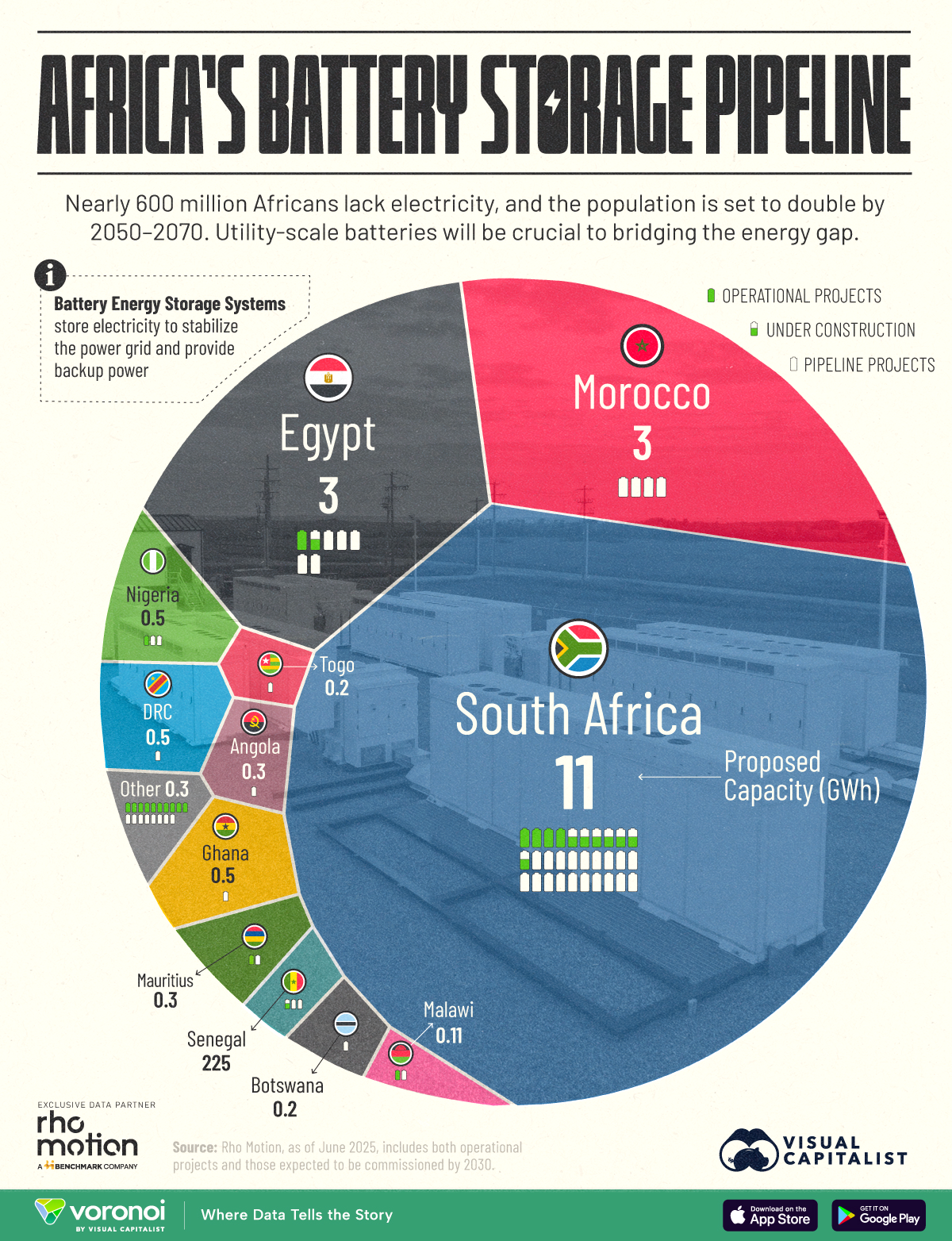![]()
See this visualization first on the Voronoi app.

Visualizing Africa’s Battery Storage Pipeline
This was originally posted on our Voronoi app. Download the app for free on iOS or Android and discover incredible data-driven charts from a variety of trusted sources.
Key Takeaways
- Battery Energy Storage Systems (BESS) store electricity to stabilize the power grid and provide backup power.
- South Africa dominates Africa’s planned battery storage capacity.
Nearly 600 million people in Africa lack access to electricity, and the continent’s population is projected to double between 2050 and 2070. This growing demand underscores the urgent need for scalable, reliable energy solutions.
As Africa transforms its power infrastructure, utility-scale batteries such as Battery Energy Storage Systems (BESS) are becoming essential. These technologies help stabilize energy supply, manage the intermittency of renewables, and support off-grid systems critical to expanding access.
This visualization highlights the continent’s battery storage pipeline, including projects that are operational, under construction, or in planning. It reveals both leading players and emerging markets in Africa’s energy storage landscape.
The data for this visualization comes from Rho Motion. It captures utility-scale battery storage projects across Africa as of June 2025, with projections through 2030.
South Africa Leads by a Wide Margin
With a total proposed capacity of 11 GWh, South Africa is far ahead of other African countries in deploying battery storage. Its pipeline includes 4 operational systems, 7 under construction, and 19 more in development.
Egypt and Morocco represent the next wave of battery storage growth, with 3 GWh in proposed capacity each. Both nations are investing in solar and wind infrastructure, and storage helps smooth their integration into national grids. Egypt already has projects operational and under construction, showing more near-term readiness.
| Country | Operational | Under Construction | Pipeline | Total |
|---|---|---|---|---|
| South Africa | 4 | 7 | 19 | 30 |
| Egypt | 1 | 1 | 5 | 7 |
| Morocco | 0 | 0 | 4 | 4 |
| Senegal | 0 | 1 | 2 | 3 |
| Nigeria | 1 | 0 | 2 | 3 |
| Mauritius | 1 | 0 | 1 | 2 |
| Malawi | 1 | 0 | 1 | 2 |
| Togo | 0 | 0 | 1 | 1 |
| Ghana | 0 | 0 | 1 | 1 |
| DR Congo | 0 | 0 | 1 | 1 |
| Botswana | 0 | 0 | 1 | 1 |
| Angola | 0 | 0 | 1 | 1 |
| Other | 10 | 0 | 8 | 18 |
Meanwhile, countries like Nigeria, Senegal, Ghana, and the Democratic Republic of the Congo have smaller but notable footprints. Most have total storage pipelines under 3 GWh, with smaller-scale projects crucial for powering remote communities and testing new energy business models across Africa.
Learn More on the Voronoi App ![]()
If you enjoyed today’s post, check out Visualizing China’s Battery Recycling Dominance on Voronoi, the new app from Visual Capitalist.